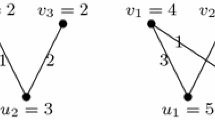Abstract
Several network-flow problems with additional constraints are considered. They are all special cases of the linear-programming problem and are shown to be ℘-complete. It is shown that the existence of a strongly polynomial-time algorithm for any of these problems implies the existence of such an algorithm for the general linear-programming problem. On the positive side, strongly polynomial algorithms for some parametric flow problems are given, when the number of parameters is fixed. These algorithms are applicable to constrained flow problems when the number of additional constraints is fixed.
Similar content being viewed by others
References
G. M. Adel'son-Velskii, E. A. Dinic, and A. V. Karzanov.Flow Algorithms. Science, Moscow, 1975. In Russian.
C. Berge and A. Ghouila-Houri.Programming, Games and Transportation Networks. Wiley, New York, 1965.
P. J. Carstensen. The Complexity of Some Problems in Parametric, Linear, and Combinatorial Programming. Ph.D. thesis, Department of Mathematics, University of Michigan, Ann Arbor, MI, 1983.
E. Cohen. Combinatorial Algorithms for Optimization Problems. Ph.D. thesis, Department of Computer Science, Stanford University, Stanford, CA, 1991.
E. Cohen and N. Megiddo. Strongly polynomial and NC algorithms for detecting cycles in dynamic graphs.Proc. 21st Annual ACM Symposium on Theory of Computing, pp. 523–534. ACM, New York, 1989.
E. Cohen and N. Megiddo. Maximizing Concave Functions in Fixed Dimension. Technical Report RJ 7656 (71103), IBM Almaden Research Center, San Jose, CA 95120–6099, August 1990.
E. Cohen and N. Megiddo. Strongly polynomial time and NC algorithms for detecting cycles in periodic graphs.J. Assoc. Comput. Mach. To appear.
E. A. Dinic. Algorithm for solution of a problem of maximum flow in networks with power estimation.Soviet Math. Dokl., 11:1277–1280, 1970.
D. P. Dobkin, R. J. Lipton, and S. P. Reiss. Linear programming is log-space hard for P.Inform. Process. Lett., 8(2):96–97, 1978.
D. P. Dobkin and S. P. Reiss. The complexity of linear programming.Theoret. Comput. Sci., 11:1–18, 1980.
J. Edmonds and R. M. Karp. Theoretical improvements in algorithmic efficiency for network flow problems.J. Assoc. Comput. Mach., 19:248–264, 1972.
L. R. Ford, Jr., and D. R. Fulkerson.Flows in Networks. Princeton University Press, Princeton, NJ, 1962.
G. Gallo, M. D. Grigoriadis, and R. E. Tarjan. A fast parametric maximum flow algorithm and applications.SIAM J. Comput., 18:30–55, 1989.
A. Ghouila-Houri. Recherche du flot maximum dans certains réseaux lorsqu'on impose une condition de bouclage.Proc. 2nd International Conference on Operations Research, London, p. 156. American Mathematical Society, Providence, RI, 1960.
A. Ghouila-Houri. Une généralisation de l'algorithme de Ford-Fulkerson.C. R. Acad. Sci. Paris, 250:457, 1960.
A. V. Goldberg, É. Tardos, and R. E. Tarjan. Network Flow Algorithms. Technical Report STAN-CS-89-1252, Stanford University, 1989.
P. Gordan. Über die auflösung linearer gleichungen mit reelen coefficienten.Math. Ann., 6:23–28, 1873.
D. Gusfield. Parametric combinatorial computing and a problem of program module distribution.J. Assoc. Comput. Mach., 30:551–563, 1983.
A. J. Hoffman. A generalization of max-flow min-cut.Math. Programming, 6:352–359, 1974.
A. Itai. Two-commodity flow.J. Assoc. Comput. Mach., 25(4):596–611, 1978.
E. L. Lawler.Combinatorial Optimization: Networks and Matroids. Holt, Reinhart, and Winston, New York, 1976.
N. Megiddo. A good algorithm for lexicographically optimal flows in multi-terminal networks.Bull. Amer. Math. Soc., 83:407–409, 1977.
N. Megiddo. Applying parallel computation algorithms in the design of serial algorithms.J. Assoc. Comput. Mach., 30:337–341, 1983.
N. Megiddo. Towards a genuinely polynomial algorithm for linear programming.SIAM J. Comput., 12:347–353, 1983.
N. Megiddo. Linear programming in linear time when the dimension is fixed.J. Assoc. Comput. Mach., 31:114–127, 1984.
C. H. Norton, S. A. Plotkin, and É. Tardos. Using separation algorithms in fixed dimension.Proc. 1st ACM-SIAM Symposium on Discrete Algorithms, pp. 377–387. ACM-SIAM, New York/Philadelphia, 1990.
É. Tardos. A strongly polynomial minimum cost circulation algorithm.Combinatorica, 5(3):247–255, 1985.
E. Tardos. A strongly polynomial algorithm to solve combinatorial linear programs.Oper. Res., 34:250–256, 1986.
Author information
Authors and Affiliations
Additional information
Communicated by Harold N. Gabow.
Work on the paper was done while at Stanford University and IBM Almaden Research Center. This research was partially supported by NSF PYI Grant CCR-8858097.
Rights and permissions
About this article
Cite this article
Cohen, E., Megiddo, N. Algorithms and complexity analysis for some flow problems. Algorithmica 11, 320–340 (1994). https://doi.org/10.1007/BF01240739
Received:
Revised:
Issue Date:
DOI: https://doi.org/10.1007/BF01240739




